GANDHINAGAR: What if the trees in your playground, the quiet benches under the shade, or even the corridor where you hang out with friends are silently shaping your happiness, your grades, and how much you feel at home in school?
It may sound surprising, but new research shows that your connection with natural spaces at school isn’t just about fresh air or a quick break from class. It’s about mental health, friendships, and even how strongly you feel you belong in your school community.
The evidence comes from a recent study published on June 23, 2025, in the Malaysia Architectural Journal (MAJ, Volume 7, Issue 3). The research was carried out by Sonali Walimbe and RamaDevi Nandineni of the Manipal School of Architecture & Planning, and Sumita Rege of the Department of Occupational Therapy, all from the Manipal Academy of Higher Education, Karnataka, India.
Their work shows something many students already sense but adults often overlook: natural spaces — whether playgrounds, gardens, or even shaded corners — play a pivotal role in shaping your daily school experience.
Connection To Nature Matters In Schools
Let’s understand why this research is so crucial. Schools are fundamental institutions, shaping everything from your academic achievements to your social skills.
However, there’s a worrying trend: studies show a decline in children’s environmental awareness, largely because they’re spending less time and engaging less with natural spaces. Richard Louv even coined the term “nature deficit” in 2005 to describe this increasing disconnection between young people and the natural world.
Reconnecting isn’t just about a change of heart; it’s about developing a deep awareness that aligns with the natural processes that have shaped human existence for millennia.
Why should schools be at the forefront of this reconnection? Because you spend a significant amount of your time there, learning and developing. Schools are diverse places, accommodating students with varying ages, interests, and abilities, and they aim to provide a nurturing and educational environment both indoors and outdoors.
The spaces within a school – classrooms, labs, libraries, playgrounds, courtyards, gardens, corridors – all serve different functions and evoke different meanings for students. While the physical school environment can make students feel like they belong or feel alienated, school design has often focused narrowly on structured learning areas, overlooking the importance of other spaces.
Yet, a substantial amount of your non-class time is spent on school grounds, offering crucial opportunities for physical exercise, relaxation, and enjoyment, which can significantly improve motivation, mood, and overall mental health. These interactions on school grounds can impact every aspect of school life.
The concept of “school connectedness” is vital for childrens’ holistic development. It’s about their sense of belonging and engagement within the school community, encompassing their attitudes towards school and your relationships with peers, teachers, and staff. This is an emotional bond, highlighting the multifaceted nature of your relationship with significant places. Therefore, nurturing a welcoming and cohesive school atmosphere that encourages positive connections and enriching experiences across the entire school environment is paramount.
Photovoice: Empowering Student Perspectives
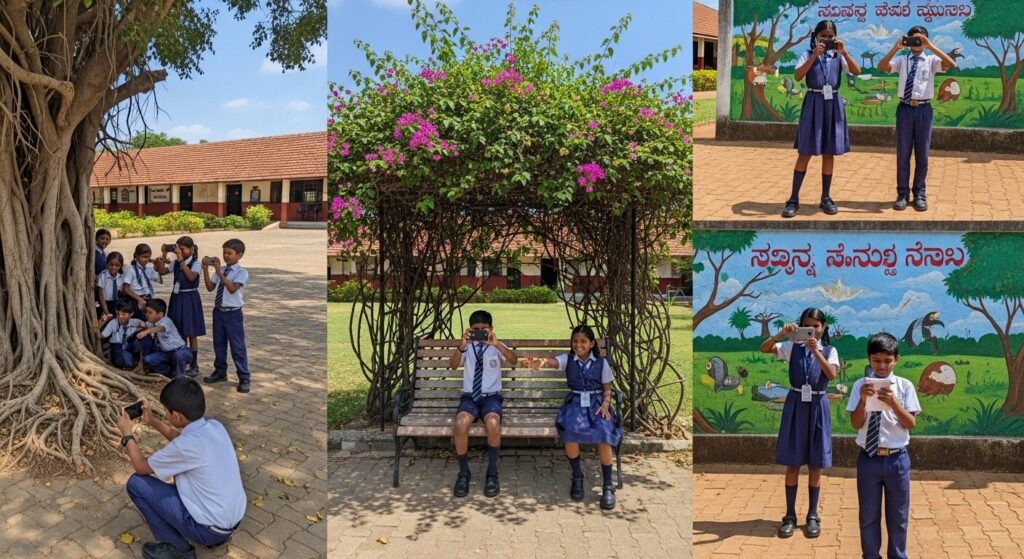
Traditional research methods, often relying on adult observations or questionnaires, can miss the complex nuances of children’s experiences, especially for younger kids. This is where photovoice steps in – an innovative and effective research tool that combines photography with participant narratives, allowing you to express yourselves visually.
This method is particularly suited for individuals who might struggle with verbal communication, empowering them to document their educational experiences and opinions through images. The act of narrating these photographs also encourages deeper self-reflection and understanding.
For this study, photovoice offered a unique chance to directly engage students in documenting and expressing their perceptions of their school environments, including what fostered their sense of connection and their opportunities for exploration.
The Research Up Close: How it Worked
The study involved 10 students aged 11 to 18 (grades 6-12) from a school in the Udupi district of Karnataka, India.
This age group is particularly important because middle childhood (6-12) is when children become more aware and appreciative of nature, fostering affection and curiosity for living things, while early to late adolescence (11-18) brings a growing desire for independence, identity exploration, and a heightened awareness of environmental issues, leading to a sense of responsibility for the environment.
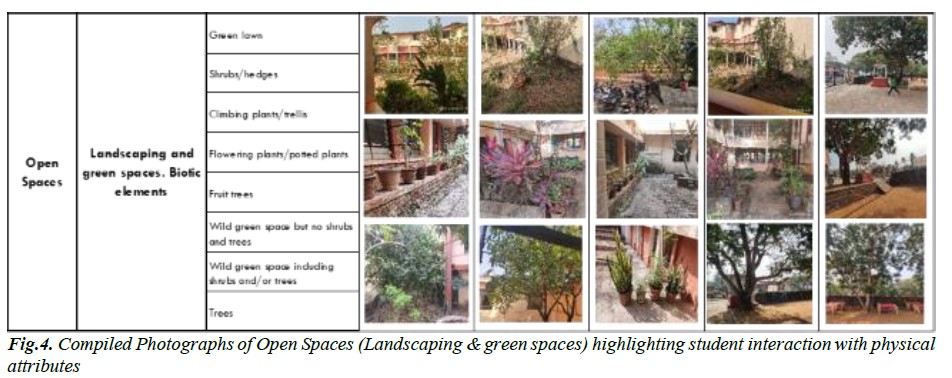
The methodology was simple:
- Photo Shooting: Participants were briefed on the study’s goal and asked to take a maximum of 10 photos of their favorite places within the school premises in ten minutes. Limiting the number of photos helped students concentrate on what they truly wanted to communicate.
- Talking About Photos: Each child then participated in a one-on-one interview, using questions like, “What do you see in this picture?”, “What is happening here?”, and “Why did you take this picture?”. These discussions were recorded and transcribed.
- Data Analysis: The images and transcripts were the primary data sources. Photos were grouped into three broad categories based on their physical characteristics: Open Spaces, Semi-Open Spaces, and Built Spaces. Within these categories, the researchers analyzed the children’s descriptions through three key themes: Emotional Connection (Affective), Behavioral Engagement (Behavioral), and Cognitive Understanding (Cognitive). Pseudonyms were used to protect participants’ confidentiality.
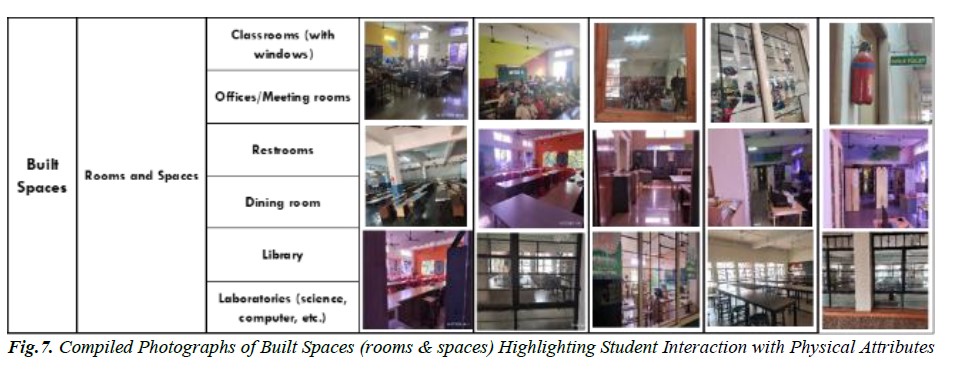
What Students Revealed: A Deeper Look at School Spaces
The study’s findings show how different school spaces contribute to students well-being and connection to nature.
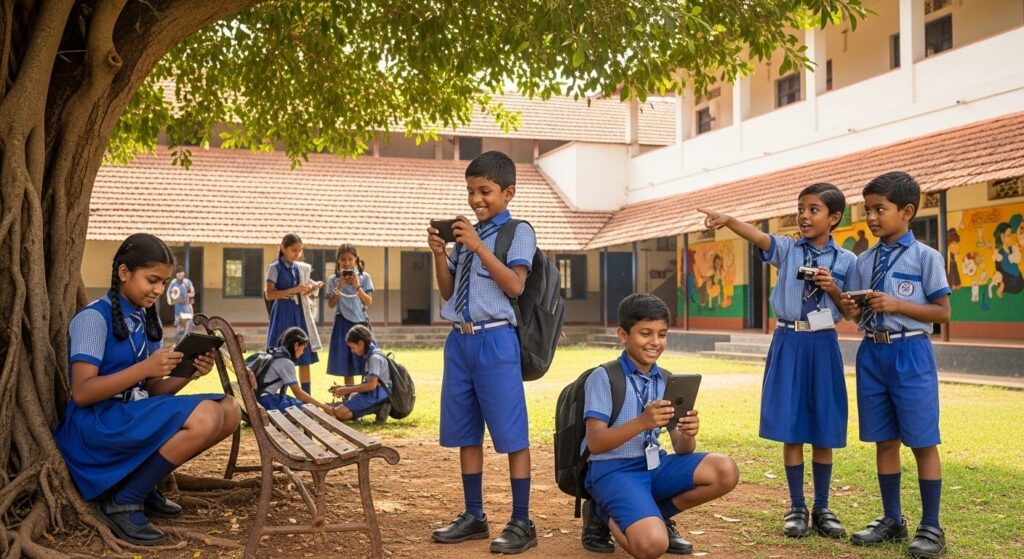
1. Open Spaces & The Heartbeat of School Life
Open spaces, like playgrounds, maidans, pitches, outdoor seating, and landscaped areas, emerged as vital hubs for connection and well-being.
- Playgrounds/Maidans/Pitches:
- Emotional Connection: Students highlighted the social aspect (friends) and positive emotions like peace, calmness, and an uplifted mood while being under trees and surrounded by nature.
- Behavioral Engagement: These spaces were multi-functional, hosting sports (basketball, cricket), sitting and talking, running, and PT exercises. The mention of a natural breeze showed a connection to sensory experiences.
- Cognitive Understanding: Students appreciated natural elements like trees, plants, and flowers, linking them to relaxation and enjoyment, even if not explicitly stating ecological importance.
- Insight: The school ground profoundly impacts students’ emotional and social well-being, fostering interaction and providing a crucial connection with nature for relaxation.
- Outdoor Seating:
- Emotional Connection: These areas were all about social interaction (friends, gossip) and relaxation, with students enjoying natural scenery (plants, flowers, leaves, cool breeze), which boosted their mood.
- Behavioral Engagement: Activities included sitting, talking, enjoying the breeze and shade, resting after playing, and even fun competitions on steps.
- Cognitive Understanding: Students connected plants, trees, and shade with feelings of relaxation, enjoyment, and creating memories.
- Insight: Benches under trees offer a relaxed setting for social interaction, rest, and a deeper connection with nature through sensory experiences.
- Landscaping & Green Spaces:
- Emotional Connection: Students found emotional comfort and a sense of peace in these tranquil spaces. They described sitting and talking with friends, observing changing flora (hibiscus, white flowers), and feeling calmed by plants and birds, especially before and after exams. A sense of wonder came from observing flower varieties.
- Behavioral Engagement: Activities included sitting, talking, observing plant growth and fallen fruit (Indian berries), and exploring flora changes across seasons.
- Cognitive Understanding: Students showed awareness of the natural world, mentioning specific plant types, fruits, and seasonal changes (ripening season).
- Insight: These green spaces provide a tranquil environment for relaxation and social interaction, fostering an awareness of nature’s cycles and contributing to peace of mind.
2. Semi-Open Spaces: Blending Indoors and Outdoors
These areas, often architectural features or amenities, bridge the gap between purely open and completely enclosed spaces.
- Architectural Features/Amenities:
- Emotional Connection: Students found peace and calmness in quiet corridors and felt happy seeing the combination of buses and trees. This suggests an appreciation for the harmonious blend of human-made and natural elements.
- Behavioral Engagement: Activities included sitting and talking with friends at water facilities while enjoying tree views and using quiet corridors during breaks.
- Cognitive Understanding: There was awareness of surroundings, with mentions of trees and nature, indicating recognition of these elements in their environment.
- Insight: Semi-open spaces offer diverse opportunities that enhance well-being, fostering positive emotions, social interaction, and awareness of the natural world, even in transitional areas.
3. Beyond the Classroom Walls
Even within the traditional “built” areas of the school, students found meaningful connections and opportunities for growth.
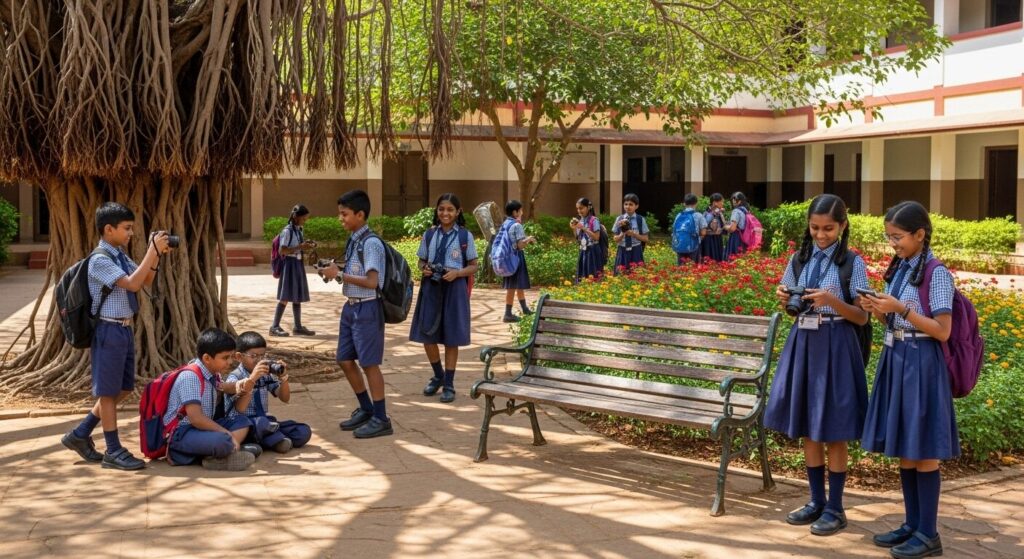
- Circulation Spaces (e.g., Atriums, Staircases):
- Emotional Connection: Students expressed enjoyment from watching assemblies, learning new things, playing sports, and the thrill of winning table tennis competitions. The staircase offered a calming pause area with views to nature.
- Behavioral Engagement: These spaces were used for playing badminton and table tennis, attending assemblies and presentations, and physical education periods. They even highlighted doing “seva” (service) activities.
- Cognitive Understanding: Students demonstrated awareness of the different functions these spaces served, recognizing an atrium as a badminton court, an assembly hall, or a place for service activities, and a table tennis room for practice and competitions. They noted learning new things during assemblies.
- Insight: Built circulation spaces provide opportunities for enjoyment, learning, and physical activity. Interestingly, students expressed a desire for more nature indoors, suggesting adding indoor plants that they could care for in the atrium. This highlights their innate understanding of nature’s benefits.
- Rooms & Spaces (e.g., Library, Science Labs, Classrooms):
- Emotional Connection: The library’s quiet atmosphere was a source of comfort for reading and studying. Students found enjoyment in reading with friends and doing science experiments, while classrooms fostered a sense of fun and companionship.
- Behavioral Engagement: Activities included reading and browsing books in the library, conducting experiments in science labs, and socializing with friends during breaks and while reading.
- Cognitive Understanding: The library was seen as a place for acquiring knowledge, and science labs were linked to learning scientific concepts through experimentation.
- Insight: These spaces cater to diverse student needs, from quiet study and knowledge acquisition in the library to hands-on learning in labs and crucial social interaction in classrooms.
- Elements of Aesthetics/Building Blocks/Building Spaces (e.g., Wall of Fame, Entrance, Windows):
- Emotional Connection: Students felt pride seeing their achievements on the wall of fame and inspiration from messages at the entrance. A window view of nature and greenery brought relaxation, and greenery in corridors added to a positive atmosphere. They enjoyed playing outdoors, PT exercises, and socializing.
- Behavioral Engagement: Activities included observing sports from windows, playing various games, socializing in different areas, and learning about the school’s history from the wall of fame.
- Cognitive Understanding: The wall of fame reminded them of the school’s history and their own achievements, and the mention of plants and trees showed awareness of the natural environment.
- Insight: The school is portrayed as a vibrant place full of life and opportunities. It fosters a sense of belonging, motivates students, offers relaxation through nature views, enjoyment through games and friends, and even informal learning. Students create personal connections based on these varied activities and experiences.
The Big Picture: What This Means for Every School
The study’s findings paint a vivid picture: your school environment, especially its grounds and natural elements, significantly shapes your emotional and social well-being.
These spaces are not just functional areas; they are social hubs where you relax, connect with friends, and create lasting memories. The presence of trees, plants, and green spaces enriches these experiences, fostering peace, enjoyment, and a natural backdrop for social interaction.
Areas adorned with natural elements were described as refuges and sources of comfort, offering opportunities for interaction, relaxation, and a connection to the changing seasons. Students expressed a sense of wonder and appreciation for the natural world through observing plant growth and birds.
Even the aesthetics of various places, like the harmonious blend of buses with trees or quiet corridors, contributed to relaxation and positive emotions. The library, labs, and classrooms also serve diverse needs, from quiet study to hands-on learning and vital social interaction.
Crucially, the study highlighted the potential for integrating nature into indoor environments. Students, with their keen awareness of nature’s benefits, suggested adding indoor plants and even proposed student-led nature clubs to care for them, further embedding nature awareness and engagement within the school.
Overall, the school is seen as a place brimming with life and opportunities for connection. It fosters belonging through recognition, motivates through inspirational messages, and provides relaxation, enjoyment, and even unofficial learning. Through their unique perspectives, students form personal connections to spaces based on their activities and experiences.
Why Your Voice is Powerful
This research demonstrates that the photovoice method is incredibly effective for understanding how students experience their surroundings and perceive the interconnected spaces of their school environment. It’s a method that truly allows children to voice their experiences and views, revealing the “hidden language” of the school environment.
The study’s conclusions strongly suggest a vital shift in how we design school environments: we need to move beyond purely functional spaces and focus on nurturing your connection with nature. This means actively integrating green spaces, promoting outdoor activities, and, most importantly, incorporating children’s voices into the planning process.
By fostering a relationship with nature within school walls, we can cultivate a generation of environmentally conscious individuals with a deep appreciation for the natural world. We need to understand what you want by listening to your voices and then incorporate those insights into building designs, creating environments truly evolved through student perspectives.
Looking Ahead: What Needs to Happen Next
While this study offers powerful insights, it’s important to note its limitations, such as a limited sample size and lack of racial and ethnic variety, which means its findings might not be generalizable to all schools. However, its implications are significant.
The findings offer potential approaches for enhancing school design to foster nature connectedness in young people. Future research should:
- Repeat similar studies with more diverse student samples to see if new or consistent trends emerge.
- Conduct studies across different regions and schools for meaningful comparisons.
- Explore the relationship between built environments and nature connectedness quantitatively, examining the link between opportunities for outdoor time during the school day and student outcomes.
- Most importantly, future school-based photovoice research should empower students to share their work and findings directly with school leaders, ensuring their insights drive actual change.
So, the next time you find yourself enjoying a cool breeze under a tree on campus, remember: you’re not just taking a break. You’re part of a vital connection, and your experiences are telling a powerful story about how schools can be designed to better support your well-being, learning, and deep connection to the natural world.


